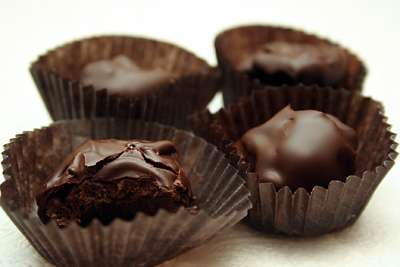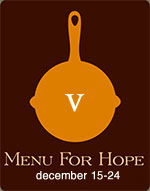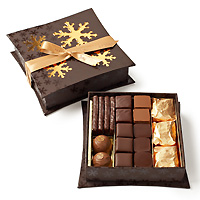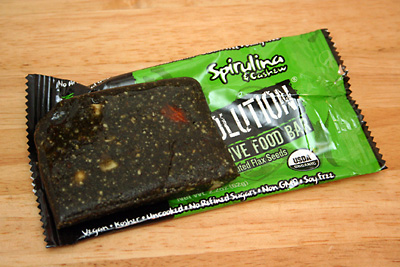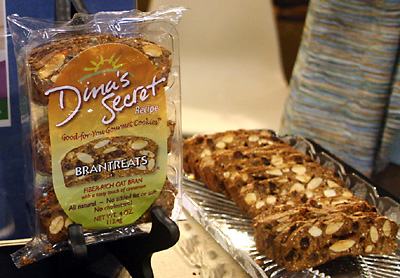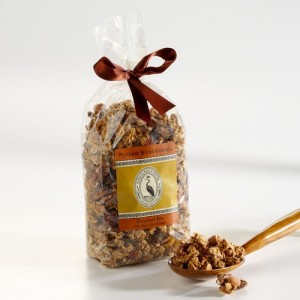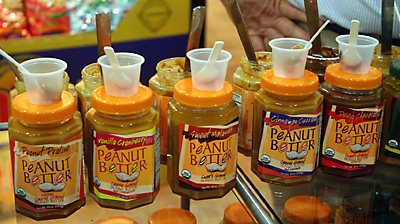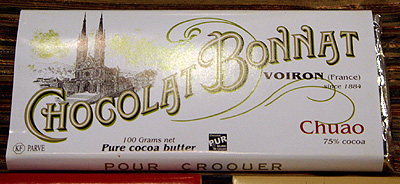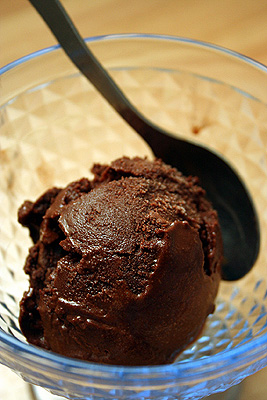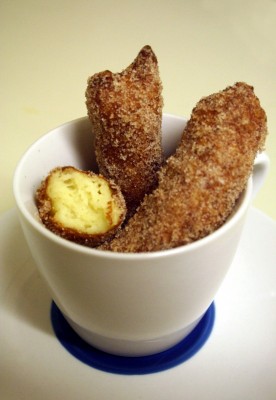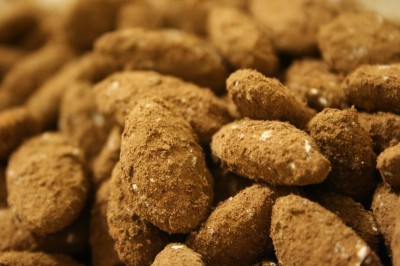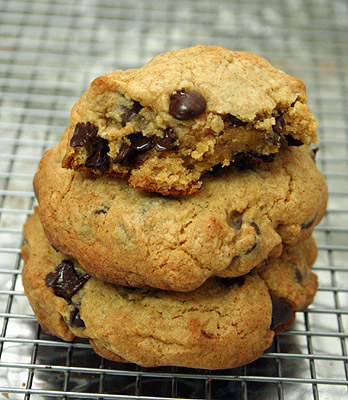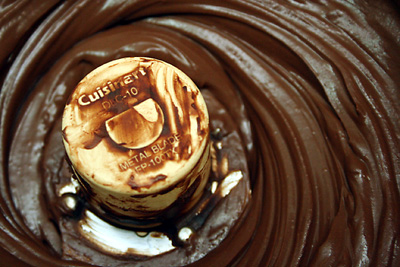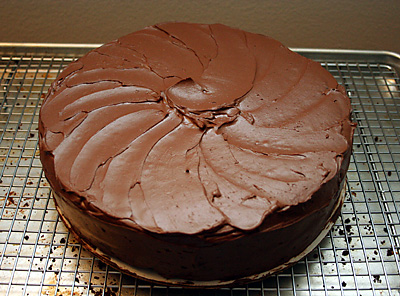Vegan Valentine’s Day Truffles
What do you do with leftover frosting? If you have a little, you can lick it off your finger or spread some on toast. But when I have a whole cup left, I turn it into truffles. Because the filling is too soft to handle at room temperature, I freeze it prior to dipping. When you eat the truffles at room temperature, the filling explodes in your mouth. It’s so good that you’ll want to make frosting just for truffles.
You can probably use any frosting as the base, but ones with a high percentage of chocolate will melt in your mouth. I used Cook’s Illustrated‘s vegan ganache frosting. If you eat the truffles fresh, I swear no one will be able to detect the tofu. After a couple days, there is a slight spicy/beany flavor, but these are still some of the best truffles I’ve ever had.
These truffles require tempered chocolate, a process that involves heating, cooling and stirring chocolate. It’s laborious and virtually impossible to do without a thermometer. Fortunately, Alice Medrich developed a cheater’s method: Melt the chocolate at a low temperature and forget about the technical stuff. It requires chocolate that’s already in temper (one that looks smooth and glossy, not one with white streaks because it’s been sitting in your car).
This Valentine’s Day, make these vegan truffles or the simplest cream truffles ever (That recipe goes like this: Heat up cream. Pour over chocolate. Eat.).
Vegan Chocolate Truffles
Adapted from Cook’s Illustrated and Alice Medrich’s Cookies and Brownies
For truffle filling:
10 ounces semisweet chocolate, finely chopped (about 1 2/3 cup)
1/4 cup hot brewed coffee
2 tablespoons boiling water
1/4 cup light coconut milk
2 ounces silken tofu (recommended brand: Morinu)
For coating:
8 ounces semisweet chocolate, finely chopped (about 1 1/3 cup)
2 ounces extra chocolate, in 1 or 2 chunks
Special equipment:
Electric mixer
Melon baller scoop or a sharp knife
2 large sheet pans
Heatproof glass bowl with a 2 1/2- to 3-quart capacity
Instant-read thermometer
Rubber spatula
Roasting pan or large baking pan at least 2 inches deep
Make filling:
- Set a medium bowl over a saucepan of barely simmering water. Place the chocolate in the bowl, and pour the hot coffee and boiling water over the chocolate. Whisk until smooth, then add coconut milk and whisk until incorporated.
- Blend the chocolate mixture and tofu in food processor until smooth and combined, 10 to 15 seconds, scraping down bowl once or twice.
- Transfer the mixture to a medium bowl and cover with plastic wrap. Refrigerate until cool and texture resembles firm cream cheese, 1 to 1 1/2 hours. (If the mixture has been chilled longer and is very stiff, let stand at room temperature for 1 hour.)
- With an electric mixer, beat the mixture at high speed until fluffy, mousse-like, and it forms medium stiff peaks, 1 to 1 1/2 minutes.
- Spread the mixture into a shallow pan and freeze until firm enough to scoop, at least 3 hours.
- Have ready a bowl of hot water, a melon baller, a sheet pan lined with wax paper, and the firm filling. Dip the melon baller into the water and wipe dry. Scoop out a scant 1-inch ball of the filling. Set on the prepared sheet pan and repeat with the remaining truffle base. If you don’t have a melon-baller, use a sharp knife to cut the base into little squares. Roll each piece between your fingers until it resembles a ball.
- Freeze the filling again until firm, about 1 hour.
Temper chocolate:
Tempering chocolate involves a sequence of heating, stirring, and cooling that stabilizes the cocoa butter and ensure that the chocolate becomes snappy and shiny. This method works only if it’s followed carefully. First, start with a fresh bar of solid chocolate. It should still be in temper if it’s glossy rather than gray or dull. The trick is to melt the tempered chocolate gently, so the temper isn’t destroyed. This method can’t be used for chocolate that is out of temper; been melted to an unknown temperature; or looks dull, spotted, or gray.
Use good chocolate, not chocolate chips or coating (which aren’t really chocolate). Don’t work in a hot room. Don’t let any moisture touch the chocolate. Don’t try to rush the process with extra heat, and DO chop the chocolate as finely as directed. Make sure that the inside of the bowl, the spatula, and the thermometer stem are clean and dry. Whenever you take the temperature of the chocolate or the water, wipe the stem clean and dry with a paper towel.
- Cut 8 ounces of chocolate into pieces the size and shape of matchsticks, or chop it into small pebble-size pieces (you can also do this in batches in a food processor). Put the chocolate in the bowl and set the bowl in a roasting pan. Set the extra two ounces of chocolate chunks aside.
- Pour hot tap water (120° to 130° F) into the roasting pan until it reaches just above the level of the chocolate in the bowl. Let sit for 5-6 min., or until the chocolate around the sides of the bowl begins to melt. Stir with a rubber spatula until the chocolate pieces are sticky and are begin to form together. There will be barely enough melted chocolate to accomplish this.
- Remove the bowl of chocolate from the roasting pan, and replenish with hot tap water. Put the bowl back in the pan and let sit for 2-3 minutes. Begin stirring with the spatula, turning the sticky mass over and over. Keep stirring (it may take 5 minutes), spreading the chocolate against the sides of the warm bowl and scraping it off as it melts. Don’t replenish the hot water; it’s still warm enough.
- When 3/4 of the chocolate is melted, check its temperature. If it is less than its maximum temperature of 90° F for dark chocolate (88° F for milk chocolate or white chocolate), continue to stir. Remove the bowl from the warm water as soon as the chocolate reaches the maximum temperature, even if it hasn’t melted entirely.
- Wipe the outside of the bowl dry. Stir the chocolate for at least 30 seconds, to equalize the temperature and melt any remaining pieces. The chocolate is now melted and still in temper. Use it for dipping immediately.
- If you accidentally exceed the maximum temperature, even by only a couple of degrees, the chocolate will probably be out of temper. Keep the bowl out of the roasting pan. Add the reserved chocolate chunks and stir until the temperature of the melted chocolate falls below the maximum (90° F for dark chocolate, 88° F for milk chocolate or white chocolate). The chunks will not be entirely melted, but the chocolate will be back in temper.
- To test it, smear a dab of chocolate, 1/16-inch thick, on a small piece of wax paper and put it in a cool place in the room or in the refrigerator. If the smear begins to dry and set within 5 minutes in a cool place or 3 minutes in the refrigerator, it’s back in temper. Remove the chunks and refrigerate for 10 minutes, then reserve for reuse. Stir the chocolate thoroughly before dipping. If the smear still looks wet and shiny, continue to stir the chunks of chocolate in the bowl for 2 to 3 minutes more and test again. Repeat until the chocolate is in temper.
- Stir the chocolate occasionally as you work with it. If it cools or thickens too much, set the bowl in a pan of water only 2 degrees warmer than the maximum temperature for the chocolate (see above), and stir until the chocolate is rewarmed.
Coat truffles:
- Line another sheet pan with wax paper.
- With your right hand (left if you are left-handed), fingers together and slightly cupped, scoop a large handful of melted chocolate into your left hand. Rub both hands together to coat them with a thick layer of chocolate. Try not to coat your fingers. Quickly pick up a frozen center with your left hand and roll it gently between your hands with a circular motion and as little pressure as possible, just long enough to cover it with a coating of chocolate. Add chocolate to your hands as necessary.
- Set the truffles on the other prepared sheet and let harden.
- Truffles keep at room temperature, in a well-sealed container, for one week.

